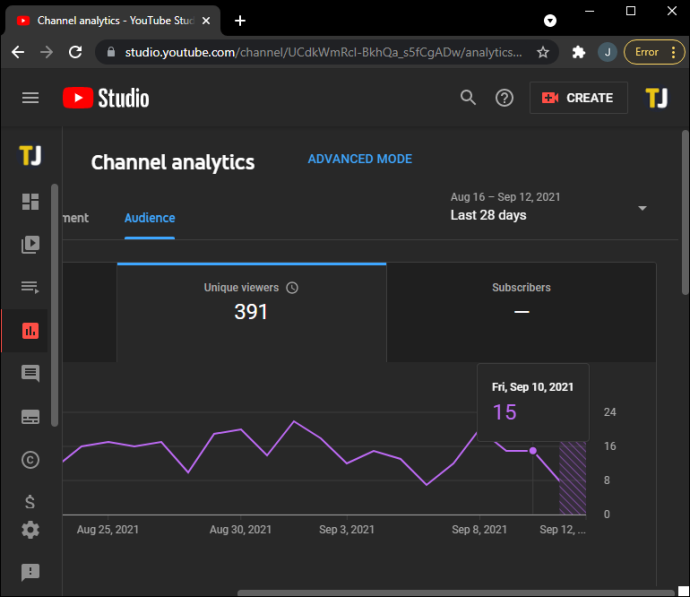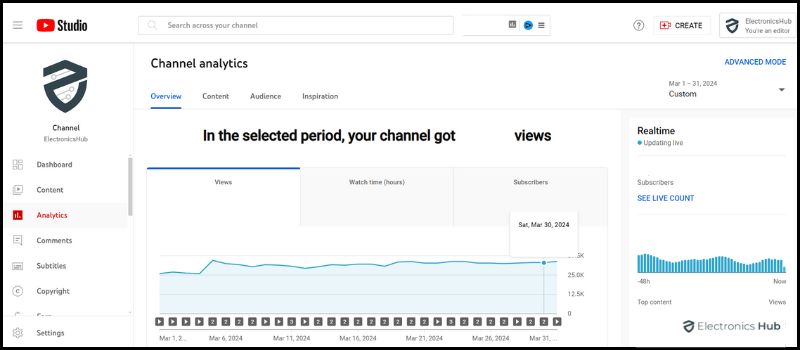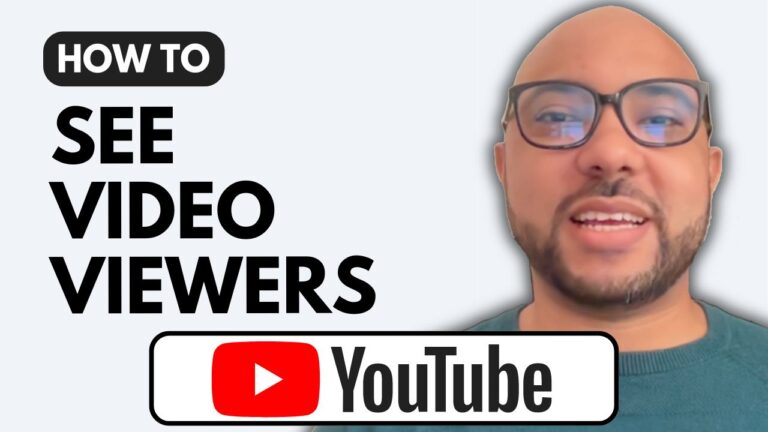Understanding YouTube Viewer Insights is essential for anyone looking to enhance their video strategy. With millions of videos uploaded daily, figuring out who's engaging with your content can help you tailor your approach, improve viewer retention, and connect better with your audience. In this post, we’ll explore the ins and outs of YouTube Viewer Insights and uncover the importance of knowing who viewed your video. Let's dive in!
Why Knowing Who Viewed Your Video Matters

So, you might be wondering: why does it even matter who viewed your videos? While YouTube doesn’t give you a list of individual users who watched your content, the analytical data it provides can give you serious insights into your audience’s behavior. Here’s why understanding your viewers is crucial:
- Audience Engagement: Knowing who is watching your videos helps you gauge how engaging your content is. If you notice that specific demographics are more likely to engage, you can create tailored content that speaks directly to them.
- Content Strategy: Analytics help inform your content strategy. By identifying the types of videos that attract particular viewer segments, you can produce more of what your audience loves. Are they more into tutorials, vlogs, or reviews? The data will tell you!
- Timing and Promotion: Viewer insights can inform when to post. If data shows that a certain demographic typically watches your videos during weekends, you might want to schedule your uploads accordingly.
- Building Community: Knowing your audience better allows you to foster a sense of community. By engaging with frequent viewers or responding to comments from specific groups, you can create a loyal fanbase that feels valued and understood.
- Monetization Opportunities: For creators looking to earn from their content, knowing your audience can also attract potential sponsors. Advertisers often want to reach specific demographics, so having this information can create monetization avenues.
Let’s unpack some of these points further. When you gain insights into the age, gender, and location of your viewers, you can tailor your content not only in style but also in substance. For instance, if your video analytics show that a significant portion of your audience is teens interested in gaming, you might think about creating more gaming content, or even collaborating with influencers in that niche.
Additionally, the geographical data is fascinating. If your viewership spikes in a particular country, consider creating content relevant to that culture or language. This approach not only enhances viewer satisfaction but can also give your videos a broader reach.
Lastly, leveraging insights on viewer behavior such as average watch time, when viewers drop off, or what they click on next can lead you to major improvements in your video-making process. Analyzing these patterns helps you not just to retain viewers but to also improve the overall quality of your videos.
In conclusion, while you won’t get an individual viewership list, understanding the collective insights from your YouTube analytics can transform your channel into a more engaging and successful platform. With the right approach, you can turn those viewers into a community that eagerly anticipates your content!
Also Read This: How to See Dislikes on YouTube Videos Using Your iPhone
3. How to Access YouTube Analytics

If you're looking to gain insights into your YouTube channel's performance, accessing YouTube Analytics is your first step. It's a powerful tool that lets you dive deep into who your viewers are, how they interact with your videos, and what content resonates most with them. To get started, follow these simple steps:
- Log into Your YouTube Account: Use the account linked to your channel.
- Go to YouTube Studio: Click on your profile icon in the top right corner. From the drop-down menu, select "YouTube Studio." This hub is where all the magic happens.
- Navigate to Analytics: On the left-hand sidebar, you'll see a variety of options. Click on "Analytics" to open up a whole new world of data.
Once you're in the Analytics section, you'll see various tabs such as Overview, Reach, Engagement, and Audience. These sections offer different insights:
- Overview: This tab provides a general idea of your video's performance, including total views, watch time, and subscriber changes.
- Reach: Discover how viewers find your videos, whether it's from search results, suggested videos, or external sources.
- Engagement: Here, you can see how long viewers are watching and which videos keep them hooked.
- Audience: This section reveals demographic information, such as the age, gender, and location of your viewers. It’s like having a crystal ball into who’s tuning in!
Don't rush through this process! Spend some time getting familiar with the layout and exploring each section. You'll find that understanding these numbers can lead to smarter content creation decisions. Plus, you can track your growth over time, so you know what's working well and what isn't.
Also Read This: Identifying Fake YouTubers: Red Flags and Tips to Spot Inauthentic Content
4. Understanding Viewer Data on YouTube

At the heart of YouTube Analytics is viewer data — and understanding this data can significantly enhance your content strategy. When we talk about viewer data, we're referring to the various metrics that tell you about your audience and their behavior. Let's break down some key metrics that you should pay attention to:
- Watch Time: This is the total number of minutes that viewers spend watching your content. Higher watch time is generally a good sign, as it indicates that your videos are engaging.
- Average View Duration: This metric shows you how long viewers are watching your videos on average. If it's significantly lower than the total length of your videos, it could be time to rethink your content strategy.
- Traffic Sources: Knowing how people find your videos is crucial. Are they coming from search, recommendations, or social media? This insight allows you to optimize your content for those channels.
- Top Videos: This section will show you which videos are performing the best. Pay attention to common themes or topics that could inspire your future videos.
- Demographics: Understanding who your viewers are can help tailor your content. This includes age ranges, gender distribution, and geographic location.
By analyzing this data, you can adjust your content strategy to better align with your audience's interests. For example, if you notice a lot of viewers dropping off after a certain point, consider whether the content is engaging enough or if the length could be adjusted. Or, if you see that a video is being widely shared, think about what you're doing right and how you can replicate that success in future projects.
Utilizing YouTube's viewer data doesn't just help you understand your current audience; it can also provide valuable insights for growing your channel. The more in tune you are with your audience, the better you'll be at creating content that resonates with them.
Also Read This: How Much Does YouTube Pay for 1M Views in Pakistan? An Overview
5. Key Metrics to Monitor in Viewer Insights
Understanding YouTube Viewer Insights is like having a treasure map—it shows you where the gold is hidden and helps you navigate your channel’s growth. To make the most of this opportunity, you'll want to keep a keen eye on several key metrics. Here are the crucial ones to focus on:
- Watch Time: This is the total number of minutes people have spent watching your video. It’s one of the most important metrics because it directly impacts your video's ranking in search results. More watch time generally means more visibility.
- Views: Though it might seem basic, the number of views your video gets provides insight into how well your content resonates with your audience. It's the starting point for understanding viewer engagement.
- Audience Retention: This metric shows you how well your video keeps viewers engaged. Are they sticking around for the whole video, or are they clicking away early? High audience retention rates mean your content is captivating!
- Demographics: Knowing who your viewers are—age, gender, and location—can help tailor your content to meet their needs. If you discover that a significant portion of your audience is from a specific age group, you can customize your topics to suit their interests.
- Traffic Sources: This tells you where viewers found your video. Is it from search, suggested videos, or external sites? Understanding traffic sources can help you optimize your promotion strategies.
- Click-Through Rate (CTR): This percentage shows how many people clicked on your video after seeing the thumbnail. A low CTR could mean your thumbnail or title is not enticing enough.
- Engagement Metrics: Likes, dislikes, comments, and shares are all important. They not only provide feedback on your content but also tell YouTube (and you) how engaged your audience is.
These metrics form the backbone of your YouTube strategy. Regularly checking and analyzing them will help you identify trends, understand audience preferences, and tweak your content for better performance.
Also Read This: Do YouTubers Get Paid for Likes? Understanding YouTube’s Monetization System and Earnings
6. How to Use Viewer Insights to Improve Your Content
Now that we’ve covered the key metrics to monitor, let’s talk about how you can actually use this data to refine and enhance your YouTube content. Remember, the numbers are only as powerful as the insights you draw from them. Here are some practical steps to help you turn insights into action:
- Analyze Successful Videos: Start by examining your top-performing videos. What topics, formats, or styles worked best? Take notes on what engages your audience and try to replicate that in future content.
- Address Drop-Off Points: Look closely at your audience retention graph to find where viewers are dropping off. If you notice a significant drop at a certain point, consider revising that section. Maybe it's too long, too slow, or less engaging than the rest!
- Tailor Content to Demographics: Utilize the demographic insights to create content that speaks to your audience. For example, if your primary audience is teens interested in gaming, consider focusing more on trending games or related content that appeals to them.
- Experiment with Thumbnails and Titles: If your CTR is low, try A/B testing different thumbnails and titles. The right combination can drastically increase your views!
- Engage with Your Audience: Use the comment section to engage directly with your viewers. Ask for feedback and suggestions about future topics. This interaction not only builds community but also provides direct insight into what your audience wants to see next.
- Test Different Formats: Don’t be afraid to step out of your comfort zone. If you primarily create vlogs, try tutorial videos or live streams. Viewer insights can guide you on which formats are more successful.
By actively utilizing viewer insights, you’re not just passively creating content, but rather crafting a tailored experience that resonates with your audience. YouTube is an evolving platform, and keeping your finger on the pulse of your viewer metrics is the best way to ensure you stay relevant and, most importantly, liked! So take a deep dive into those analytics, and watch your content soar.
Also Read This: How to Change Your YouTube Short Thumbnail to Increase Click-Through Rates
7. Common Misconceptions About Video Views and Analytics
YouTube is an incredible platform for creators to share their content, but with great opportunity comes a host of misunderstandings, especially around video views and analytics. Let’s clear the air on some of the most common misconceptions.
1. More Views Equals More Revenue
Many new creators assume that the number of views directly correlates with earnings. While views are a significant factor, revenue also depends heavily on audience engagement, ad formats, and demographics. High view counts don’t always mean high profits—engaged viewers who interact with your content (like, comment, share) can be more valuable.
2. You Can See Exactly Who Watched Your Videos
It’s a common belief among creators that they can track individual viewers who watch their videos. Sadly, this isn’t the case due to privacy policies. YouTube only provides aggregate data, meaning you can see total views and demographics but not specific identities.
3. All Views Are Equal
Not all views have the same value. A view from a user who watches the whole video is more beneficial than a view from someone who clicked on your video and left after a few seconds. YouTube’s algorithm favors videos that keep viewers engaged, so focus on creating quality content that resonates with your audience.
4. Analytics Are Only for Monetized Channels
Some creators believe that YouTube analytics are only useful for those making money. In reality, analytics can provide valuable insights for all creators. Whether you’re looking to grow your audience or refine your content strategy, understanding viewer behavior can help you make informed decisions.
5. More Subscribers Mean Higher Views
Another misconception is that a higher subscriber count guarantees more views. While subscribers are more likely to watch your videos, many factors influence how often your content is viewed, including SEO, video quality, and audience interest.
6. Engagement Metrics Don’t Matter So Much
Many creators overlook the importance of likes, comments, and shares. These metrics are crucial because they signal to YouTube that your content is valuable, and they can boost your video’s reach in searches and recommendations. So, encourage your viewers to engage!
7. YouTube SEO Is a One-Time Task
It’s a mistake to think that optimizing your videos for search is a one-and-done task. YouTube is always changing its algorithms, and new trends emerge regularly. Continual optimization—like updating descriptions and tags or creating fresh content—can keep your channel growing.
By debunking these misconceptions, you can approach your YouTube journey with a clearer understanding of what to expect from video views and analytics. This will help you make data-driven decisions that enhance your content strategy and grow your audience.
8. Conclusion and Next Steps for YouTube Creators
As we wrap up our exploration of YouTube viewer insights, it’s clear that understanding analytics is not just for seasoned creators but is essential for anyone looking to thrive on the platform. Here are some of the next steps you can take to harness this information effectively:
- Dive into Your Analytics: Spend time familiarizing yourself with YouTube Studio. Try to interpret the data regarding demographics, watch time, and traffic sources. Look for trends in what kinds of videos perform best and identify patterns in viewer behavior.
- Experiment with Content: Use the insights you've gained to experiment with different types of content. Don’t be afraid to mix it up! Whether it’s trying a new format or changing up your posting schedule, use your analytics to guide your experiments.
- Engage with Your Audience: Based on viewer feedback and engagement metrics, take the time to respond to comments and ask your audience what they want to see. Building a community is just as important as producing quality content.
- Educate Yourself Continually: Stay updated with YouTube’s latest features and algorithm changes. Join creator forums, participate in webinars, and read up on case studies from successful creators to absorb new strategies.
- Monitor Performance Regularly: Make analyzing your video performance a regular habit rather than a one-time task. This keeps you informed and nimble, allowing you to pivot when necessary.
Channel growth takes time, but through the use of YouTube analytics, you can gain valuable insights that will significantly enhance your strategy. Remember, every video is a learning opportunity. Keep adjusting your approach, and don't hesitate to reach out for help or collaboration within the YouTube community. Good luck!
 admin
admin








